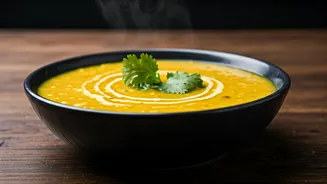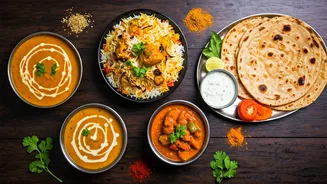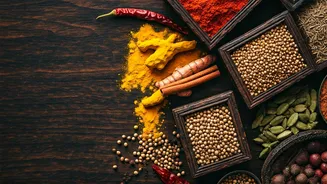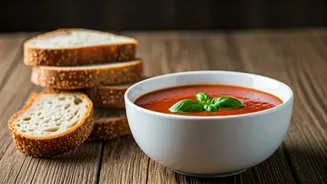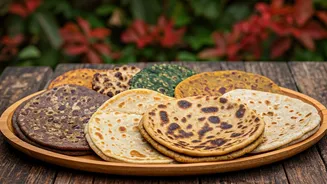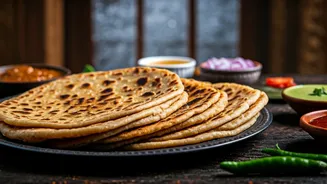Introduction: A Culinary Journey
The Mahabharata, an epic tale of war, dharma, and devotion, also offers a fascinating peek into ancient Indian cuisine. Food played a significant role
in the lives of the characters, from elaborate feasts to simple meals. This article explores six recipes inspired by the Mahabharata, providing a taste of the culinary practices of that era. These recipes have been passed down through generations, adapted to contemporary kitchens while preserving their authentic flavors. Prepare to discover the tastes that fueled heroes and shaped ancient India.
1. The Royal Thali
Imagine a feast fit for a king, and you have the essence of the Royal Thali. This is not just a single dish; it's an elaborate spread of various dishes, each carefully prepared and arranged to create a balanced meal. The thali typically includes rice, various vegetable curries, lentil dishes (dal), yogurt, chutneys, and breads like roti or puri. The ingredients would have been sourced from local farms and gardens, reflecting the season's bounty. Spices such as turmeric, cumin, coriander, and cardamom would have been used liberally, lending rich flavors and aromas. Preparing a Royal Thali is a labor of love, requiring time and attention to detail, mirroring the grandeur associated with the epic tale.
2. Kichadi: A Simple Meal
Kichadi, a humble yet nourishing dish, was a staple during times of war and travel, appreciated for its simplicity and ease of preparation. This one-pot meal typically combines rice, lentils (usually moong dal), and vegetables, seasoned with basic spices like turmeric and cumin. The exact ingredients would have varied based on availability, but the core concept remained the same: a balanced and easily digestible meal. Kichadi provided essential nutrients and energy. Its preparation didn't require advanced cooking skills or a large number of ingredients. Kichadi is a testament to the fact that even in times of scarcity, a satisfying and nourishing meal could be prepared.
3. Vegetable Curry Variations
Vegetable curries were a cornerstone of the Mahabharata's culinary landscape, with recipes differing significantly depending on the region and available ingredients. The curries could feature seasonal vegetables, such as spinach, eggplant, gourds, and beans. The cooking process often involved sautéing the vegetables in ghee (clarified butter) or oil, followed by the addition of spices and a base of onions, tomatoes, and ginger-garlic paste. Coconut milk was added to provide a creamy texture. These curries were served with rice or bread and often accompanied other dishes. Variations would be determined by the availability of spices and vegetables. This offered a diverse range of flavors and textures, ensuring that the meals were varied and exciting.
4. Lentil Soups (Dals)
Lentils, or dals, held a significant place in the daily diet. They were a crucial source of protein, especially in a time where meat consumption was infrequent or limited. Dals were prepared in numerous ways, from simple preparations with minimal spices to rich, creamy stews with a variety of ingredients. Popular lentils such as moong, masoor, and chana dal were used, each offering a unique texture and flavor. The cooking methods generally involved boiling the lentils with water and adding spices, such as turmeric, coriander, and asafoetida. The consistency of the dal could vary, from a thin soup to a thick stew, based on the specific recipe and preferences.
5. Sweet Dishes (Payasam)
No meal would be complete without a sweet treat, and Payasam would often grace the table during festive occasions. Payasam is a milk-based dessert, with rice, vermicelli, or lentils as its base. Sweeteners, such as jaggery or sugar, are used, and flavored with cardamom, saffron, and nuts such as cashews and almonds. The dessert is slow-cooked, allowing the flavors to meld and the milk to thicken. Payasam showcases the art of creating delicious desserts with simple ingredients. It highlights the importance of sweets in the Indian culture, often served at celebrations or special occasions. This provides a satisfying end to a traditional meal.
6. Refreshing Beverages
While not directly part of a recipe, beverages were crucial. Buttermilk or lassi, made from yogurt and water, served as refreshing drinks. These drinks aided digestion and provided a cooling sensation, particularly useful in the hot Indian climate. Spiced water, infused with ingredients like mint, ginger, and cumin, was another popular choice. These beverages were designed to complement the rich, often spicy, food. They were essential for hydration. These drinks demonstrate the importance of balancing flavors and the emphasis on digestive health in ancient Indian cuisine. They ensured a satisfying and complete dining experience.


